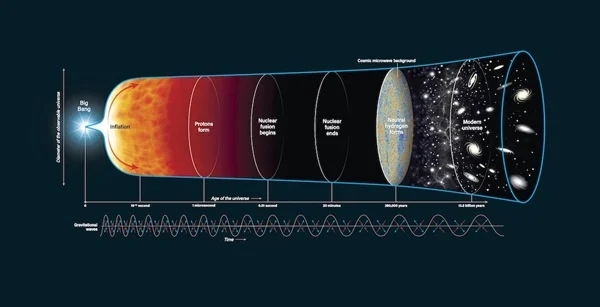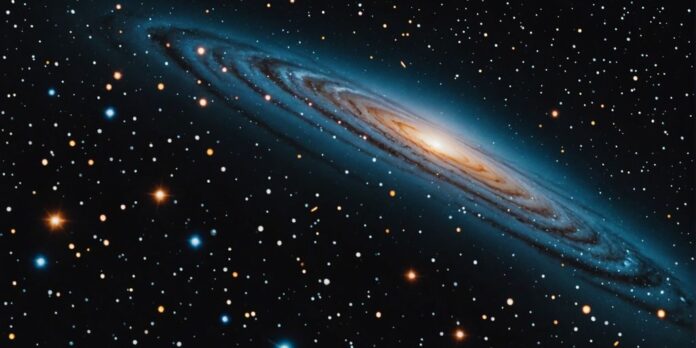The universe is a vast, mysterious place that has always fascinated us. From ancient stargazers to modern scientists, people have tried to understand its secrets. This article will take you on a journey through some of the most interesting parts of cosmic expansion. We will look at how the universe started, how it has changed, and what might happen to it in the future.
Key Takeaways
- Cosmic inflation explains the rapid expansion of the universe just after the Big Bang.
- Dark energy is a mysterious force that makes the universe expand faster over time.
- Einstein’s theory of general relativity helps us understand the fabric of space and time.
- Galactic redshifts show that galaxies are moving away from us, proving the universe is expanding.
- The cosmic microwave background radiation is a faint glow from the early universe, giving us clues about its beginning.
The Concept of Cosmic Inflation

Inflation Theory
Cosmic inflation is the idea that the universe expanded extremely fast in the first second after the Big Bang. Imagine our universe as one inflating bubble in a foam of expanding bubble universes. This rapid stretching flattened any initial space curvature, making the universe look the way it does today.
Evidence of Rapid Expansion
Scientists have found several clues that support the idea of rapid expansion. For example, the uniformity of the cosmic microwave background radiation suggests that the universe expanded quickly. This drastic stretching during inflation helps explain why the universe appears so smooth and even.
Implications for the Universe
The concept of cosmic inflation serves many useful purposes. First, it helps us understand the large-scale structure of the universe. Second, it provides a framework for explaining the distribution of galaxies and other cosmic features. Finally, it offers insights into the early moments of the universe, right after the Big Bang.
Understanding cosmic inflation is key to unlocking the mysteries of our universe’s origins and its ultimate fate.
Dark Energy and the Fate of the Universe
Nature of Dark Energy
Dark energy is a mysterious force that makes up nearly seven-tenths of the universe. Scientists know it exists because they see its effects, like galaxies moving away from each other faster and faster. But what it actually is remains unknown.
Accelerating Expansion
Observations show that the universe is not just expanding but doing so at an accelerating rate. This rapid expansion is driven by dark energy. Understanding this force is key to figuring out the ultimate fate of the cosmos.
Cosmic Destiny
The presence of dark energy means that an oscillating universe is impossible. The universe will keep expanding, and this will shape its future in ways we are still trying to understand.
The universe is nearly 14 billion years old, but humans have only been studying it for a short time. We’ve come a long way, but there’s still much to learn about how the cosmos works.
The Fabric of Spacetime
Einstein’s Theory of General Relativity
Albert Einstein’s theory of general relativity changed how we understand gravity. Instead of seeing it as a force, Einstein described it as a curvature of spacetime caused by mass and energy. This idea helps explain how planets orbit stars and how light bends around massive objects.
Curvature of Spacetime
The concept of spacetime curvature is mind-bending. Imagine a trampoline with a heavy ball in the center. The ball creates a dip, and smaller objects roll towards it. This is similar to how massive objects like stars and planets warp the fabric of spacetime, causing other objects to move towards them.
Warping of Time
Time itself can be warped by gravity. Near a massive object, time moves slower compared to a place with less gravity. This phenomenon, known as time dilation, has been confirmed by experiments and is crucial for technologies like GPS to work accurately.
The idea that ripples in space-time can be distorted by the curvature of space is a deeply important phenomenon that could unlock new secrets of the universe.
Galactic Redshifts and Cosmic Expansion
Redshift Observations
When we observe distant galaxies, we notice that their light is shifted towards the red end of the spectrum. This phenomenon, known as redshift, indicates that these galaxies are moving away from us. The greater the redshift, the faster the galaxy is receding. This observation supports the idea that the universe is expanding.
Hubble’s Law
Hubble’s Law states that the speed at which a galaxy moves away is directly proportional to its distance from us. This means that the farther a galaxy is, the faster it appears to be moving away. This relationship can be expressed with the formula:
| Distance (Mpc) | Velocity (km/s) |
|---|---|
| 1 | 70 |
| 2 | 140 |
| 3 | 210 |
Expanding Universe Model
The concept of an expanding universe suggests that space itself is stretching, causing galaxies to move apart. This doesn’t mean galaxies are traveling through space at high speeds, but rather that space is expanding, carrying galaxies with it. This model helps explain why the universe appears to be expanding without breaking the speed of light.
The idea that the universe is expanding has changed our understanding of cosmology and the universe’s ultimate fate.
Cosmic Microwave Background Radiation

Discovery of CMB
The cosmic microwave background (CMB) is a faint radiation that fills the universe. It is the afterglow of the Big Bang, which happened 13.8 billion years ago. Scientists discovered the CMB by accident in 1965 while working on a radio antenna. This discovery provided a snapshot of the universe’s early stages, offering clues about its composition and evolution.
Insights into Early Universe
The CMB gives us valuable information about the early universe. By studying this radiation, scientists can learn about the conditions that existed just after the Big Bang. The CMB shows tiny temperature differences that reveal how matter was distributed in the early universe. These differences eventually led to the formation of galaxies and other structures we see today.
Cosmic Fossil
The CMB is often called a “cosmic fossil” because it is a remnant from the early universe. It helps scientists understand the universe’s history and how it has changed over time. The study of the CMB continues to provide new insights into the nature of the universe and its origins.
Conclusion
The universe is a vast and mysterious place, full of wonders that continue to amaze us. From the rapid expansion of the cosmos to the puzzling nature of dark energy, we have only scratched the surface of understanding. The study of spacetime, redshifts, and the cosmic microwave background radiation has given us glimpses into the universe’s past and its possible future. As we keep exploring and learning, each discovery brings us closer to unraveling the secrets of the universe. The journey is far from over, and the cosmos still holds many mysteries waiting to be discovered.
Frequently Asked Questions
What is cosmic inflation?
Cosmic inflation is a theory that suggests the universe expanded extremely fast right after the Big Bang. This rapid expansion helps explain why the universe looks the same in all directions.
Why is dark energy important?
Dark energy is a mysterious force that makes up most of the universe. It is believed to be responsible for the accelerating expansion of the universe.
How does Einstein’s Theory of General Relativity relate to spacetime?
Einstein’s Theory of General Relativity explains how gravity works by describing how mass and energy warp spacetime. This warping creates what we feel as gravity.
What is redshift and why is it important?
Redshift is the stretching of light to longer wavelengths as objects in space move away from us. It is important because it provides evidence that the universe is expanding.
What is the Cosmic Microwave Background (CMB) Radiation?
The CMB is faint radiation left over from the early universe, just after the Big Bang. It gives us a snapshot of what the universe looked like when it was very young.
What is the fate of the universe?
The fate of the universe is still uncertain. It could keep expanding forever, slow down and stop, or even collapse back in on itself. Scientists are still studying dark energy to understand this better.
